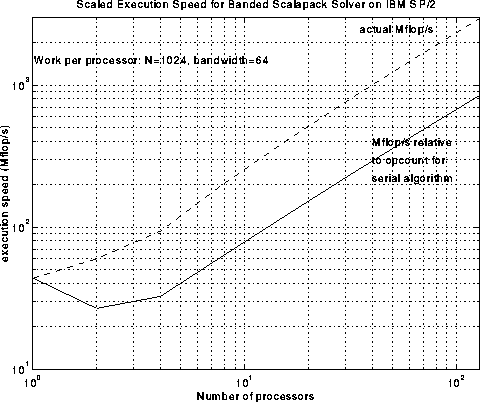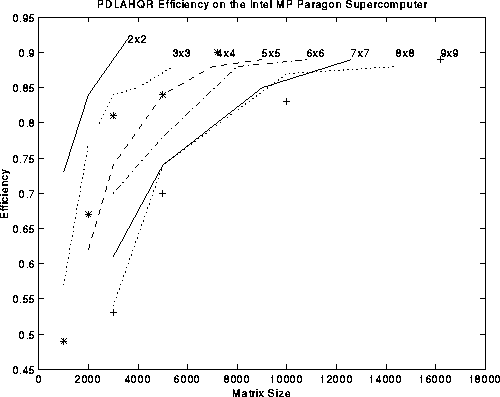The best grid shape is determined by the algorithm implemented in
the library and the underlying physical network. A one link physical
network will favor or
, where
is
the process grid. This affects the scalability
of the algorithm, but reduces the overhead due to message collisions.
It is possible to predict the best grid shape given the number
of processes available. The current algorithms for the factorization
or reduction routines can be split into two categories.
If at every step of the algorithm a block of columns and/or rows
needs to be broadcast, as in the LU or QR factorizations,
it is possible to pipeline this communication phase and overlap it
with some computation. The direction of the pipeline determines the
shape of the grid. For example, the LU, QR and QL factorizations
perform better for ``flat'' process grids ( ). These
factorizations share a common bottleneck of performing a reduction
operation along each column (for pivoting in LU, and for computing
a norm in QR and QL). The first implication of this observation
is that large latency message passing perform better on a ``flat''
grid than on a square grid. Secondly, after this reduction has been
performed, it is important to update the next block of columns as
fast as possible. This is done by broadcasting the current block of
columns using a ring topology, i.e, feeding the ongoing communication
pipe. Similarly, the performance of the LQ and RQ factorizations take
advantage of ``tall'' grids (
) for the same reasons, but
transposed.
The theoretical efficiency of the LU factorization can be estimated by (3):
For large n, the last term in the denominator dominates, and it is
minimized by choosing a 
.
works
well on Intel machines. For smaller n, the middle term dominates,
and it becomes more important to choose a small

constant as P increases, thus we
have
and
, where u and v
are constant [10]. Moreover, let us ignore the
factor for a moment. In this case,
and
are proportional to
and
must grow with P
to maintain efficiency. For sufficiently large

factor cannot be ignored, and the performance will slowly degrade
with the number of processors P. This phenomenon is observed in
practice as shown in Figure 10 for the efficiency of the
LU factorization on the Intel Paragon.
The second group of routines are two-sided algorithms as opposed to one-sided algorithms. In these cases, it is not usually possible to maintain a communication pipeline, and thus square or near square grids are more optimal. This is the case for the algorithms used for implementing the Cholesky factorization, the matrix inversion and the reduction to bidiagonal form (BRD), Hessenberg form (HRD), tridiagonal form (TRD) and the nonsymmetric QR eigenvalue algorithm (HQR). For example, the update phase of the Cholesky factorization of a lower symmetric matrix physically transposes the current block of columns of the lower triangular factor.
Assume now that at most P processes are available. A natural
question arising is: could we decide what process grid
should be used? Similarly, depending
on P, it is not always possible to factor
to
create the appropriate grid. For example, if P is prime, the
only possible grids are
and
. If such
grids are particularly bad for performance, it may be beneficial
to let some processors remain idle, so the remainder can be formed
into a ``squarer'' grid [24].
These problems can be analyzed by a complicated function of the
machine and problem parameters. It is possible to develop models
depending on the machine and problem parameters which accurately
estimate the impact of modifying the shape of the grid on the total
execution time, as well as predicting the necessary amount of extra
memory required for each routine.
Figure: Intel Paragon LU and QR Performance
Figure: IBM SP-2 and Intel Paragon Cholesky Factorization

Figure: Execution speed in Mflop/s for the band algorithm on the IBM SP-2.

Figure: Performance of the Parallel QR Algorithm on the Intel MP Paragon for
a 2x2 up to a 9x9 grid of processes.
Figure: Performance with different blocksize NB (MB=NB) and
prediction of percentage of time to performance operations.
Figure: IBM SP-2 and Intel Paragon Performance